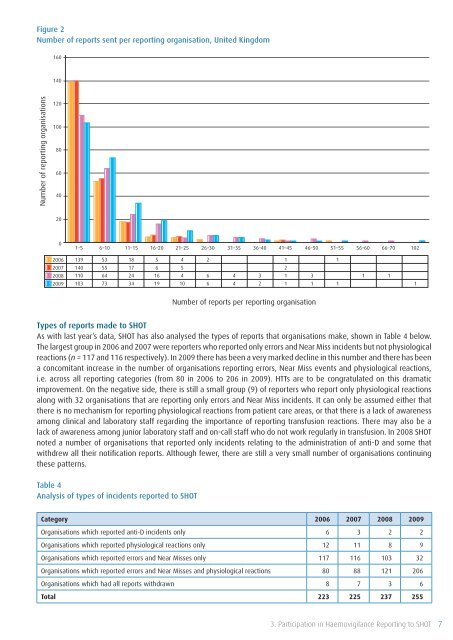SHOT Annual Report 2009 - Serious Hazards of Transfusion
SHOT Annual Report 2009 - Serious Hazards of Transfusion
SHOT Annual Report 2009 - Serious Hazards of Transfusion
You also want an ePaper? Increase the reach of your titles
YUMPU automatically turns print PDFs into web optimized ePapers that Google loves.
Figure 2<br />
Number <strong>of</strong> reports sent per reporting organisation, United Kingdom<br />
160<br />
140<br />
Number <strong>of</strong> reporting organisations<br />
120<br />
100<br />
80<br />
60<br />
40<br />
20<br />
0<br />
1–5<br />
6–10<br />
11–15<br />
16–20<br />
21–25<br />
26–30<br />
31–35 36–40 41–45<br />
46–50<br />
51–55<br />
56–60<br />
66–70<br />
102<br />
2006<br />
139<br />
53<br />
18<br />
5<br />
4<br />
2<br />
1<br />
1<br />
2007<br />
140<br />
55<br />
17<br />
6<br />
5<br />
2<br />
2008<br />
110<br />
64<br />
24<br />
16<br />
4<br />
6<br />
4<br />
3<br />
1<br />
3<br />
1<br />
1<br />
<strong>2009</strong><br />
103<br />
73<br />
34<br />
19<br />
10<br />
6<br />
4<br />
2<br />
1<br />
1<br />
1<br />
1<br />
Number <strong>of</strong> reports per reporting organisation<br />
Types <strong>of</strong> reports made to <strong>SHOT</strong><br />
As with last year’s data, <strong>SHOT</strong> has also analysed the types <strong>of</strong> reports that organisations make, shown in Table 4 below.<br />
The largest group in 2006 and 2007 were reporters who reported only errors and Near Miss incidents but not physiological<br />
reactions (n = 117 and 116 respectively). In <strong>2009</strong> there has been a very marked decline in this number and there has been<br />
a concomitant increase in the number <strong>of</strong> organisations reporting errors, Near Miss events and physiological reactions,<br />
i.e. across all reporting categories (from 80 in 2006 to 206 in <strong>2009</strong>). HTTs are to be congratulated on this dramatic<br />
improvement. On the negative side, there is still a small group (9) <strong>of</strong> reporters who report only physiological reactions<br />
along with 32 organisations that are reporting only errors and Near Miss incidents. It can only be assumed either that<br />
there is no mechanism for reporting physiological reactions from patient care areas, or that there is a lack <strong>of</strong> awareness<br />
among clinical and laboratory staff regarding the importance <strong>of</strong> reporting transfusion reactions. There may also be a<br />
lack <strong>of</strong> awareness among junior laboratory staff and on-call staff who do not work regularly in transfusion. In 2008 <strong>SHOT</strong><br />
noted a number <strong>of</strong> organisations that reported only incidents relating to the administration <strong>of</strong> anti-D and some that<br />
withdrew all their notification reports. Although fewer, there are still a very small number <strong>of</strong> organisations continuing<br />
these patterns.<br />
Table 4<br />
Analysis <strong>of</strong> types <strong>of</strong> incidents reported to <strong>SHOT</strong><br />
Category 2006 2007 2008 <strong>2009</strong><br />
Organisations which reported anti-D incidents only 6 3 2 2<br />
Organisations which reported physiological reactions only 12 11 8 9<br />
Organisations which reported errors and Near Misses only 117 116 103 32<br />
Organisations which reported errors and Near Misses and physiological reactions 80 88 121 206<br />
Organisations which had all reports withdrawn 8 7 3 6<br />
Total 223 225 237 255<br />
3. Participation in Haemovigilance <strong>Report</strong>ing to <strong>SHOT</strong><br />
7












